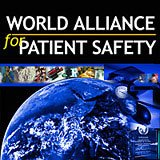
Close

The first challenge launched by the World Alliance for Patient Safety focusing on the prevention of healthcare-associated infection.
 The vision was simple: to initiate a commitment by all ( policymakers, frontline staff, patients, and managers) to make “Clean Care is Safer Care” an everyday reality in all countries and everywhere that health care is provided.
The vision was simple: to initiate a commitment by all ( policymakers, frontline staff, patients, and managers) to make “Clean Care is Safer Care” an everyday reality in all countries and everywhere that health care is provided.
The challenge promotes hand hygiene, blood safety, injection and immunization safety, safer clinical practices and safer water, and sanitation and waste management.

Clean Care is Safer Care: The First Global Challenge of the WHO World Alliance for Patient Safety,Vol. 26 No. 11